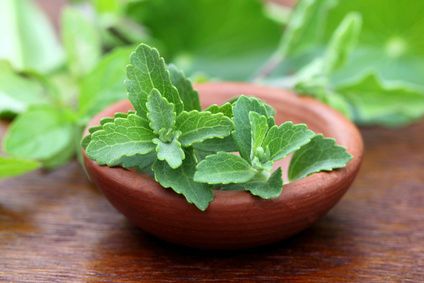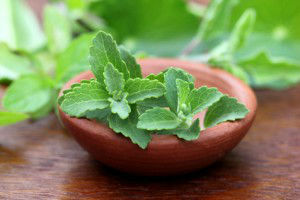
Stevia has lately been experiencing a rapid growth in popularity as a sugar substitute, and for good reason. In its raw and unprocessed state, stevia leaves provide completely natural sweetness, without adding calories or raising blood sugar levels at all. However, many of the stevia brands found on the shelves are not pure stevia.
Stevia rebaudiana is native to South America, and is especially prolific in Brazil and Paraguay. It is part of the Asteraceae family, which also includes daisies and ragweed. The leaves from this bush have been used in these countries for hundreds of years for their sweetening properties, and also for medicinal purposes including lowering blood sugar and blood pressure, relieving digestive distress and treating burns and colic.
Stevia leaves are approximately 30 to 40 times sweeter than sugar, and do not pose any of the health risks that sugar carries with it. Natural stevia extract is about 200 to 300 times sweeter than sugar. However, this is not to be confused with rebaudioside A, which is the processed stevia extract approved by the FDA for use in commercial stevia products.
The optimal way to ensure that your stevia is the real thing is to grow it yourself. All you need is a small window box, or if you prefer, a small patch of your garden. You can find starter plants at your local nursery, or from a quality online distributer. Transfer these to a 10-by-12 inch container, or to your garden, in rich soil, and do not let the roots of the new plants get too cold.
Make sure not to overwater, and you’ve got easy-to-care-for stevia. These plants also have inherent insect-repelling properties. Harvest leaves from mature plants, then use them fresh or dried, and crush by hand or in a spice grinder, if you wish. Use your stevia in any food or beverage that you want to add natural, delicious sweetness to.
If you would rather purchase your stevia, make sure that the only ingredient on the label is “whole leaf stevia” or “crushed whole leaf stevia.” No other ingredients should be added. Many brands use rebaudioside A, which has gone through a multiple-step processing treatment and is no longer in its natural form.
 A lot of stevia products also contain potentially harmful additives. Some of them even contain sugar as a second ingredient! Other common additives are maltodextrin, dextrose and erythritol. Maltodextrin and dextrose are both starches usually derived from GMO corn, and maltodextrin often contains MSG. Erythritol is a sugar alcohol also commonly derived from GMO corn.
A lot of stevia products also contain potentially harmful additives. Some of them even contain sugar as a second ingredient! Other common additives are maltodextrin, dextrose and erythritol. Maltodextrin and dextrose are both starches usually derived from GMO corn, and maltodextrin often contains MSG. Erythritol is a sugar alcohol also commonly derived from GMO corn.
If your stevia is pure, you are ready to enter a world of healthy sweetness. One word of caution, however: stevia may potentially interact with certain medications if eaten in large amounts, so if you are on a medication and plan to use a lot on a frequent basis, check with a health professional just to be extra safe.
-The Alternative Daily
Sources:
http://www.ncbi.nlm.nih.gov/pubmed/19961353
http://www.livescience.com/39601-stevia-facts-safety.html
http://www.100daysofrealfood.com/2013/04/25/stevia-food-babe-investigates
https://www.thealternativedaily.com/choose-your-stevia-wisely
https://www.thealternativedaily.com/warning-stevia-can-be-processed

